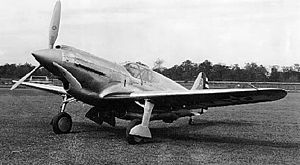

| XP-46 | |
|---|---|

| |
| Curtiss XP-46 | |
| Role | Fighter
Type of aircraft
|
| Manufacturer | Curtiss-Wright Corporation |
| First flight | 15 February 1941 |
| Primary user | United States Army Air Corps (intended) |
| Number built | 2 |
| Developed from | Curtiss P-40 |
| Developed into | Curtiss XP-53 |
The Curtiss XP-46 was a 1940s American prototype fighter aircraft. It was a development of the Curtiss-Wright Corporation in an effort to introduce the best features found in European fighter aircraft in 1939 into a fighter aircraft which could succeed the Curtiss P-40, then in production.
AUnited States Army Air Corps (USAAC) specification based upon a Curtiss proposal was the basis for an order placed in September 1939 for the XP-46. The requirements called for a single-engine, low-wing aircraft, slightly smaller than the P-40, and with a wide-track, inward-retracting landing gear. The selected powerplant was a 1,150 hp (858 kW) Allison V-1710-39 V-12 engine. The planned armament included two .50 in (12.7 mm) synchronized machine guns in the forward fuselage and provisions for eight .30 in (7.62 mm) wing-mounted guns. The USAAC later added requirements for self-sealing fuel tanks and 65 lb (29 kg) of armor, the weights of which adversely affected performance.
In 1940 the British Purchasing Commission placed an order for the P-46 as a replacement for the P-40,[1] the British service name 'Kittyhawk' was allocated by the Air Ministry in anticipation of receiving the aircraft.[2]
However, the USAAC asked Curtiss in July 1940 – while the XP-46 prototypes were under construction – to prioritize an upgraded P-40, featuring the engine intended for the XP-46. This would also avoid disruptions to the production line caused by any switch to a new airframe. The British order for the P-46 was later cancelled,[1] and the 'Kittyhawk' name subsequently applied to the upgraded P-40.
Two prototypes, designated XP-46A, were nevertheless delivered to the USAAC; the first flight occurred on 15 February 1941. The type's performance during trials was found to be inferior to the then-contemporary P-40D. As the P-46 offered no significant improvement on the P-40, the program was cancelled.[3]
A myth claims that work on the XP-46 was the basis of the North American NA-73X – the prototype P-51 Mustang. While North American Aviation (NAA) purchased technical aerodynamic data on the P-40 and XP-46 from Curtiss for $56,000, and there are certain design similarities in the radiator/oil-cooler configuration of the two types, North American had already made significant progress on its design.[4][a]

Data from Curtiss Aircraft 1907–1947[5]
General characteristics
Performance
Armament
|
Curtiss P-40 Warhawk family
| |
|---|---|
| Aircraft |
|
| Model numbers |
|
| Replicas |
|
| Topics |
|
|
| |||||||||||
|---|---|---|---|---|---|---|---|---|---|---|---|
| 1924 sequences (1924–1962) |
| ||||||||||
| Tri-service sequence (1962–present) |
| ||||||||||
| Covert designations |
| ||||||||||
| Related designations |
| ||||||||||
1 Not assigned • 2 Unofficial • 3 Assigned to multiple types | |||||||||||
|
Curtiss and Curtiss-Wright aircraft
| |||||||||||||||||||||||||||||||||||||||||||||||||||||||||
|---|---|---|---|---|---|---|---|---|---|---|---|---|---|---|---|---|---|---|---|---|---|---|---|---|---|---|---|---|---|---|---|---|---|---|---|---|---|---|---|---|---|---|---|---|---|---|---|---|---|---|---|---|---|---|---|---|---|
| Manufacturer designations |
| ||||||||||||||||||||||||||||||||||||||||||||||||||||||||
| Operator and role |
| ||||||||||||||||||||||||||||||||||||||||||||||||||||||||
1 Designation skipped 2 Not built | |||||||||||||||||||||||||||||||||||||||||||||||||||||||||